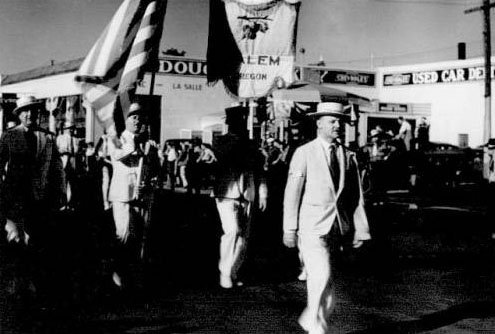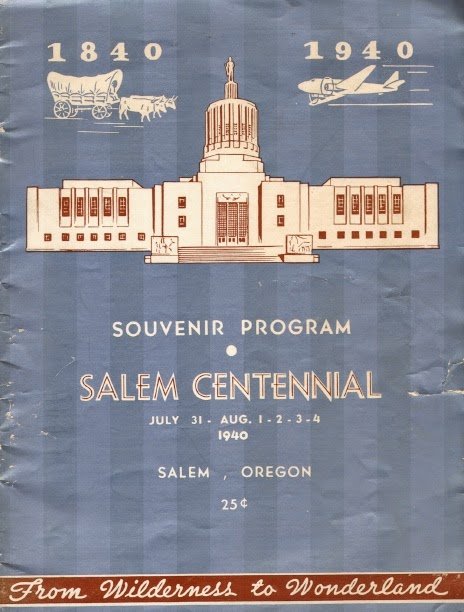World Events
- In Tibet, 4-year old Tenzin Gyatso is named the 13th Dalai Lama.
- Winston Churchill elected Prime Minister of Great Britain. In a radio address he blames Mussolini for leading Italy into war placing “the inheritors of ancient Rome upon the side of the ferocious pagan barbarians”. British forces are evacuated from Dunkirk leaving Europe under axis control. (“Dunkirk” film and “Darkest Hour” film, both 2017)
- The International Olympic Committee cancels the Summer Olympics.
- Salem’s Senator McNary was nominated for Vice President to Republican Wendell Willkie this year, but Roosevelt is elected for a third term.
- The Selective Training and Service Act creates the first peacetime draft in U.S. history. Willys Corporation introduces the “Jeep”.
- Nylon stockings are placed on sale with almost 5 million sold the first day. The McDonald brothers open a restaurant in San Bernardino, Ca. Walter Knott constructs replica of a ghost town that becomes Knott’s Berry Farm.
- Academy Award: “Rebecca”. Also popular this year, the classic “Grapes of Wrath”. Notable books: The Nazarene, Sholom Asch and How Green Was My Valley, Richard Llewellen.
In Salem
Local excitement was the all-volunteer Salem Centennial in August. Many events were public and with costumes of pioneer days. A Centennial Pageant entitled “From Wilderness to Wonderland” was produced at the State Fairgrounds. A 25-cent, illustrated booklet (cover reproduced above) was the Souvenir Program for the five days of activities throughout the city. It lists hundreds of local residents as producers and participants.

When you visit
In the scene above, the parade marchers are headed south on Commercial Street, passing the former site of Douglas McKay’s auto dealership at the northeast corner of the intersection with Marion Street. Not seen in the photograph, is a young Mark Hatfield, parading with the Salem High School band. Traffic still flows south at that intersection, but the Marion Street Bridge, added in 1954, now brings a stream of vehicles east from West Salem. Mr. McKay’s business, which became Capitol Auto Group, is no longer at that location. The Marion Square Park, across Commercial to the west, is still an oasis of evergreen trees, although the grove was much diminished in the Columbus Day windstorm of 1962.Other events
- The census reports Salem population as 30,908, one fifth the population of 2012.
- An important 1940 economic effect was the U.S. National Bank of Portland acquisition of a large portion of the Ladd and Bush Bank. Ladd and Bush Trust Company moved into the U.S. Bank building as Pioneer Trust Company. This historic institution continues to serve the Salem community as Pioneer Trust Bank.
- The first Salem family to suffer loss in World War II was that of Ralph Barnes, a foreign correspondent who had lived with his wife and two young daughters in the capitals of Europe during the years leading up to World War II. He had sent his family to England as combat began, but their safety was threatened by the German bombing of London. His wife Ester, Joan and Suzanne had returned home to Salem just a few months before Ralph died in an English reconnaissance flight crash over Yugoslavia.
- Families and friends gather at the 12th Street Railroad Station to say goodbye to young men leaving for National Guard duty.
- George Waters, in the local tobacco business, bought the Class B Western International League franchise in Bellingham, WA, and brought the pro team to Salem in 1940. On May 1, the Salem Senators christened the new Waters Field with 4,865 attendance and an 11-10 victory over the Yakima, WA, team with five runs in the ninth inning. The stadium of Waters Field later burned, leaving no prospect of rebuilding.
- The late George Strozut remembered that as a child of 7 in this year, he and other travelers were greeted with a prominent sign as they arrived at the local Greyhound bus station located at the north end of the Senator Hotel on High Street. The sign listed Salem statistics (including the fact that the population was 31,000) and concluded with the statement that the city was “99.9 percent white.”
From the Capitol Journal:
- Salem was soon to become a port of call along United Airlines route between Vancouver, B. C. and San Diego.
- In July, Chairman Ray Stumbo, in charge of construction for the Salem Centennial Pageant to be staged at the fairgrounds, reported that 20 workman were already on the job. 100,000 feet of lumber would be required to build the mountain set 300 feet wide and 40 feet deep. That same month, Marion County Court gave the Salem Centennial Committee use of the Courthouse square during the celebration for the erection of an Indian village, Red Cross first aid station and a free trapeze set. In addition, Salem merchants announced that their stores would be closed for three big centennial parades. An opening fun parade would be on July 31. Succeeding days would see the pioneer parade and the major centennial parade. It was estimated that it would take three hours for the centennial parade to pass.
- In September, over 1,100 boys and girls were enrolled in the second year of Bible instruction classes in Salem public schools.
- Gov. Charles Sprague gave unqualified support to President Roosevelt’s $1, 820, 000 national defense program, but doubted that the nation’s civilians were prepared to stand up under total war.
- Salem Grange, under its Master, Zero Polaire, started a movement for registration of all aliens in the United States as a protection against fifth column treachery that President Roosevelt warned against.
(See Ben Maxwell’s Salem, Oregon, edited by Scott McArthur, 2006.)

